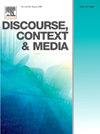Scaling as method: A three-stage, mixed-methods approach to digital discourse analysis
IF 3.1
2区 文学
Q1 COMMUNICATION
引用次数: 0
Abstract
Drawing on research on graphic contextualization cues in punctuation and typography, this paper describes a three-stage, mixed-methods approach to digital discourse analysis. It introduces the terms ‘scale’ and ‘scaling’ as methodological metaphors for a researcher’s planned, yet contingent movement through formations of digital textual data that differ in terms of volume, method of collection, processing, and analysis. ‘Scaling-as-method’ aims to replace static binaries (such as ‘micro’ and ‘macro’, ‘small’ and ‘big’ data, ‘manual’ and ‘automated’ processing) by the vision of a researcher who shifts their degree of abstraction, or ‘distance’, towards digital data, while moving from close to distant reading and back again. The paper exemplifies this three-stage process on the example of the indignation mark, aka <!!1>, a twist on the iterated exclamation mark that is attested in digital discourse in various languages as a cue of double-voicing. The explorative examination of a small dataset (Stage 1) leads to the computational collection and distributional analysis of a much larger dataset (‘scaling up’, Stage 2), followed by the manual annotation of a selected subset of this data (‘scaling down’, Stage 3). Each stage draws on a different amount of data, which enables different techniques of processing and analysis, and relies on a specific combination of abductive, deductive, and inductive reasoning. Yet all three stages complement one another in a kaleidoscopic way towards understanding connections between punctuation practices and participatory political discourse online. Scaling as method is not a closed recipe, but an adaptable procedure that can be applied to a variety of discrete digital features. It does not aim to replace established methods of computational social media analysis, but to boost research that is predominantly based on the manual collection and annotation of social media data, and to enables a dialogue between multiple understandings of context.
规模即方法:数字话语分析的三阶段混合方法
本文借鉴对标点符号和排版中图形语境化线索的研究,描述了一种三阶段混合方法的数字话语分析方法。本文引入了 "规模 "和 "缩放 "两个术语,作为研究人员在数字文本数据的形成过程中进行有计划的、偶然的移动的方法学隐喻,这些数字文本数据在数量、收集方法、处理和分析方面各不相同。缩放即方法 "旨在以研究者的视角取代静态的二元对立(如 "微观 "与 "宏观"、"小 "数据与 "大 "数据、"手工 "处理与 "自动 "处理),研究者对数字数据的抽象程度或 "距离 "发生变化,从近距离阅读到远距离阅读再到近距离阅读。本文以愤慨标记(又名<!!1>)为例,说明了这三个阶段的过程,愤慨标记是迭代感叹号的一种变形,在各种语言的数字话语中都被证明是双重发声的线索。对小型数据集的探索性研究(第 1 阶段)导致了对更大数据集的计算收集和分布分析("放大",第 2 阶段),随后是对这些数据中选定的子集进行人工标注("缩小",第 3 阶段)。每个阶段都利用不同数量的数据,从而采用不同的处理和分析技术,并依赖于归纳、演绎和归纳推理的特定组合。然而,所有三个阶段以万花筒般的方式相互补充,从而理解标点符号实践与在线参与式政治话语之间的联系。作为方法的缩放并不是一个封闭的秘方,而是一个可适用于各种离散数字特征的适应性程序。它的目的不是取代已有的社交媒体计算分析方法,而是促进主要基于社交媒体数据的手工收集和注释的研究,并促成对语境的多种理解之间的对话。
本文章由计算机程序翻译,如有差异,请以英文原文为准。
求助全文
约1分钟内获得全文
求助全文

 求助内容:
求助内容: 应助结果提醒方式:
应助结果提醒方式:


